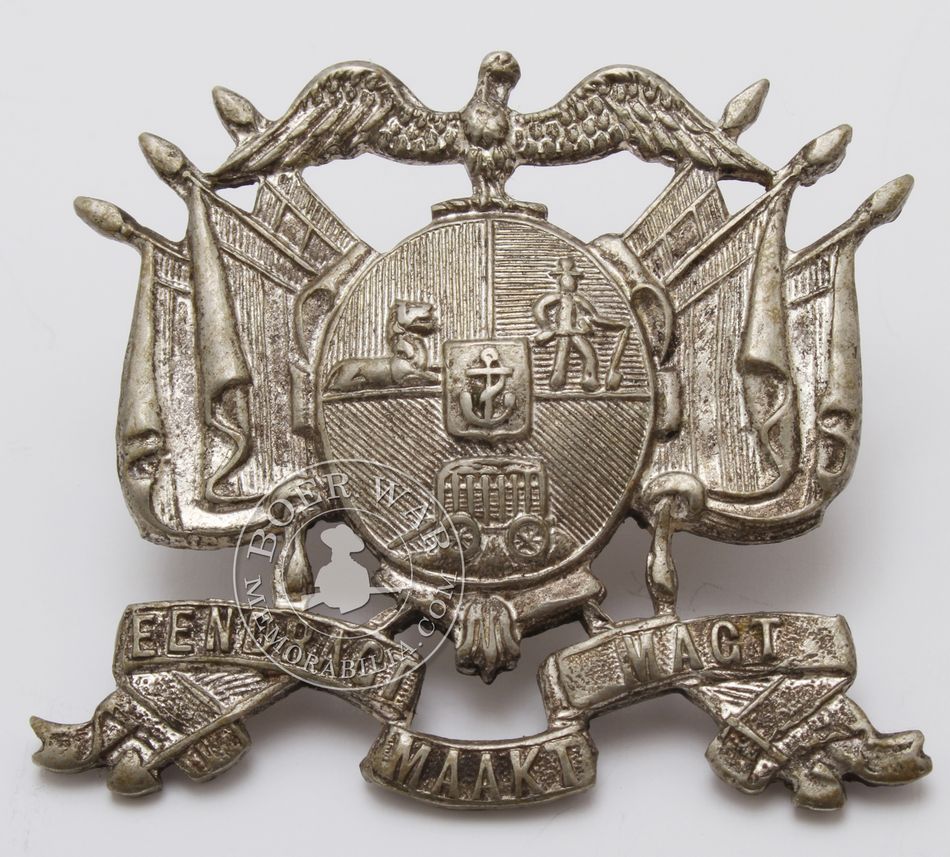|
View the embedded image gallery online at:
https://boerwarmemorabilia.com/index.php/memorabilia/military-insignia/item/108-zars-badge-3-boer-forces#sigProId6dc87fc1ca |
Item Ref# KS6131
ZAR Badge 3 - Boer Forces
Brief description: This small white metal badge was not officially used by the Zuid Afrikaansche Republiek’s Artillery Corps. However, it has been seen in photographs on various clothing items of Boers in the veld during the three years of war (1899 to 1902). Most have two rear lugs with the occasional badge found with a customised soldered pin at the back. (Transvaal Republic, white metal cap badge of the Staats Artillerie, worn 1874 to 1901) Material: White metal Manufacturer: Unknown Artist: Unknown Circa: 1890’s Dimensions: 40 x 35mm Weight: tbc Inscription: “Eendragt Maakt Magt” |

ZAR Artillery : 75mm Creusot
75mm Creusot QF (Matèriel de Campagne de 75 m/m a tir Rapide Système Schneider-Canet)
In 1896 the Transvaal imported six QF field guns from Schneider & Co to form the “1ste Rijdende Battery” (First Mounted Battery) or more commonly, the “French Battery”. A letter in the Pretoria archives gives their factory numbers as 3244 to 3249. Ironically in the Transvaal the guns soon became known as the “French Krupps”!
This gun was far ahead of its time and a pioneer of quick firing artillery. Not only did it use single-piece brass cased charges, it was also equipped with two buffer cylinders. The early buffers however only allowed 11.5 inches of recoil and therefore an axle spade and drag shoes were also fitted. Also unusual for a gun of this period was its traversing system, which allowed two degrees of traverse either way. The gun was designed to fire shrapnel at long ranges with a flat trajectory and a high muzzle velocity. This strained the carriage and buffers, which often were in need of repairs. The gun is easily recognisable by its unusual low carriage and interrupted screw breechblock.
After their capture three of the six guns were shipped to the UK. Two of these, No. 420 and 423, were donated to the Royal Artillery, while No. 421 was allotted to the Royal Engineers. Of these No. 423 was sent to the RA Mess, Wellington Lines, at Aldershot, while No. 421 went to the School of Military Engineering, Brompton Barracks, Chatham.
Of above-mentioned pieces only No. 420 could be traced at Fort Nelson, Hampshire. According to Mr. David Moore of the Palmerston Forts Society, this was the piece discovered at Piet Retief during February 1901. As with the 120mm Krupp howitzer, it was discovered taken apart and buried to hide it from British troops. The same gun is said to have stood at the Tower in London for some time before being relocated to Fort Nelson.
ORANJE VRIJSTAAT ARTILLERIE CORPS/ Historical Study and Re-Enactment Group
| Scripture |
|
Many are saying of me, "God will not deliver him." "Selah" But you are a shield around me, O LORD; you bestow glory on me and lift up my head. To the LORD I cry aloud, and he answers me from his holy hill. "Selah" I lie down and sleep; I wake again, because the LORD sustains me. I will not fear the tens of thousands drawn up against me on every side. Psalm 3:2-6 |

